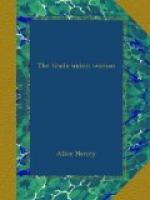The organizers attempted far too much, and neglected the slow, solid work of preparation, and the no less important follow-up work; this had much to do with the early decline of the entire organization. The women’s end of the movement suffered first and most quickly. From 1890 on, the women’s membership became smaller and smaller, until practical interest by women and for women in the body wholly died out.
But the genuine workers had sown seed of which another movement was to reap the results. The year 1886 was the year of the first meeting of the American Federation of Labor as we know it. With its gradual development, the growth of the modern trade-union movement among women is inextricably bound up.
III
THE BEGINNINGS OF MODERN ORGANIZATION
As the Knights of Labor declined, the American Federation of Labor was rising to power and influence. It was at first known as the Federation of Organized Trades and Labor Unions of the United States and Canada, and organized under its present name in 1886. For some time the Knights of Labor and the younger organization exchanged greetings and counsel, and some of the leaders cherished the expectation that the field of effort was large enough to give scope to both. The American Federation of Labor, being a federation of trade unions, kept well in view the strengthening of strictly trade organizations. The Knights, as we have seen, were on the other hand, far more loosely organized, containing many members, both men and women, and even whole assemblies, outside of any trade, and they were therefore inclined to give a large share of their attention to matters of general reform, outside of purely trade-union or labor questions. It was the very largeness of their program which proved in the end a source of weakness, while latterly the activities of the organization became clogged by the burden of a membership with no intelligent understanding of the platform and aims.
But although the absence of adequate restrictions on admission to membership, and the ease of affiliation, not to speak of other reasons, had led to the acceptance of numbers of those who were only nominally interested in trade unionism, it had also permitted the entry of a band of women, not all qualified as wage-workers, but in faith and deed devoted trade unionists, and keenly alive to the necessity of bringing the wage-earning woman into the labor movement. The energies of this group were evidently sadly missed during the early years of the American Federation of Labor.




